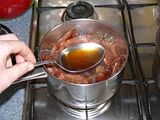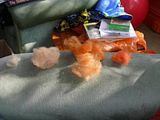Hi,
Being a fan of spider flies, and reading lots of old dressings from the 1800s and early 1900s, has brought me in contact with the phrase "stained in onions" alot. Typically when describing the hackle to some pattern (i.e. partridge, stained in onions). At first, I thought this meant the feather was dyed with a pattern that produced ridges of colour (light to dark, then light, etc). Then it occurred to me that they just meant dyed with the dye you get from onions. Ok, I admit it, I can be rather thick at times.
Anyway, while out for a walk the other day I came across some wool. Someone had shorn a sheep and there was wool scattered all over. So, being short of materials at the moment, I figured some wool would come in handy. That evening, Vanessa had cooked up some beats and so I decided I would try dying some of my wool in the beat juice (after they were removed, honest!) I added some vinegar to fix the colour, and it turned out quite good. We had some spinach cooking in another pot, and I tried that. It produced a very weak colour, but I think if more spinach were used it would produce an olive.
Next, I decided to try the infamous onion. I took the brown skins from about 7 or 8 good sized onions. Put them in a pot, covered with water, and then gently boiled them for about an hour and a half. (click on photos for a larger view)
Here's a shot of the colour of the liquid that shows up better in the spoon.
The bit to the lower right was taken out before the others. Time in the dye is something to play with to get different results. Also, I've read that different "mordants" (what you use to fix the colours so they don't wash out: malt vinegar in this case) can influence the result. Apparently things like iron, tin, alum, and chrome are used to prepare the wool, but vinigar, or salt, or urine can also be used. I only tried malt vinegar - honest.
Here are the results, of the above experiments:
Left to right we have:
undyed wool, the weak spinanch dye (very light olive), onion dye, and beat root.
It turns out that dandylions also produce a usable dye. You boil up a pot full of cut up dandylions, roots, flowers, stems, and all. Rise the dirt off first. Boild for 1 to 2 hours, longer is probably better. About 30 mintes before ready to dye the remaining wool, I took it and boiled it in some malt vingar and water, with a bit of cream of tartar dissolved in as well.
After the pot of dandylion stew was "done", I poured it through a strainer lined with paper towel to get rid of any dirt, etc. Then, just poured the wool and the water/vingear/tartar mix into the dye, and boiled it for about 30 minutes. The result is a light tan. Vanessa just asked why I didn't just roll it about in some mud. She might have a point there. Anyway, here are the final set of results, again left to right:
spininch (weak), dandylion, onion, and beat root.
I think these will produce some excellent dubbings. I'm going to try a Tup's Indespensible type mix between dandylion, onion, and beat for a "veggie tup's". Once I get my hands on a vice that is.
- Jeff








 Reply With Quote
Reply With Quote